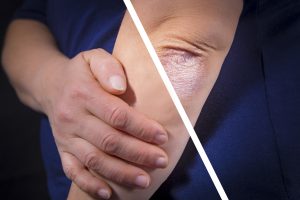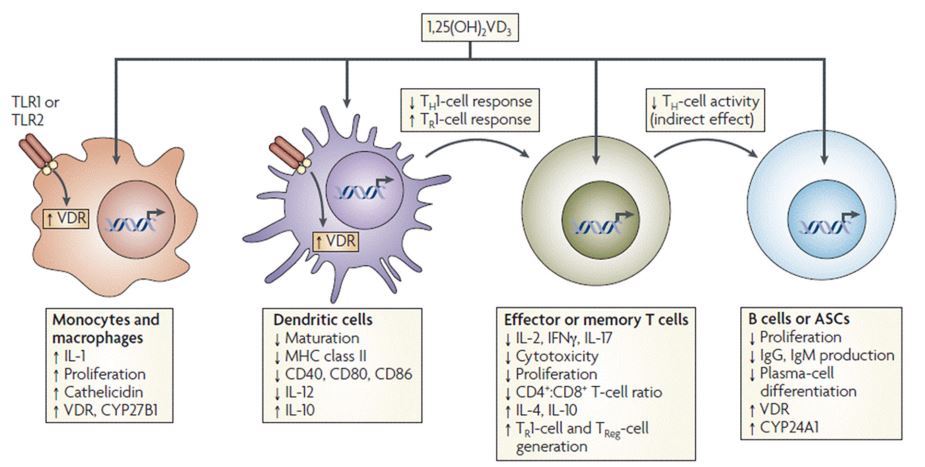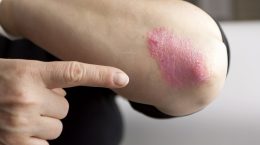Published on July 14, 2023
This review on psoriasis patients says “Yes!” and that the fear of vitamin D deficiency and its consequences should be much greater than the fear of vitamin D toxicity
Key Points
- Baseline vitamin D [as 25(OH)D] concentrations are often between 20 to 80 ng/ml (50 to 200 nmol/L) prior to vitamin D treatment in psoriasis patients, yet they still improve dramatically after treatment with oral or topical vitamin D, sunshine, or UVB phototherapy. How can that be if those values are considered sufficient and “normal” by certain medical institutions?
- Dermatologists are ignoring their own literature and are not using vitamin D to treat psoriasis. There are many reports showing that it is safe and effective.
- The mechanism of action of vitamin D in controlling psoriasis is through its action on regulatory T lymphocytes. Tregs are called the master regulators of the immune system. They depend on vitamin D to be formed and to maintain their functional status.
- Maintenance therapy (continued daily dosing of vitamin D) is needed to keep psoriasis under control because Tregs stop working when the vitamin D supply drops. This applies to other autoimmune diseases as well.
 Psoriasis is one of the most common auto-immune diseases, characterized by the cyclical appearance of raised, red patches covered by scaly, itchy skin, usually around the knees, elbows, trunk and scalp. Oral and topical vitamin D treatments, cod liver oil, sunshine exposure, and artificial UV light (emitting both UVA and UVB light) have all been shown to be beneficial for the treatment of psoriasis as well as several other dermatological conditions.
Psoriasis is one of the most common auto-immune diseases, characterized by the cyclical appearance of raised, red patches covered by scaly, itchy skin, usually around the knees, elbows, trunk and scalp. Oral and topical vitamin D treatments, cod liver oil, sunshine exposure, and artificial UV light (emitting both UVA and UVB light) have all been shown to be beneficial for the treatment of psoriasis as well as several other dermatological conditions.
A 2021 review by McCullough et al. highlights vitamin D levels among psoriasis patients and the ineffectiveness of what many consider to be sufficient vitamin D levels (above 20 ng/ml or 50 nmol/L) to improve psoriatic lesions, especially compared to post-vitamin D treatment levels. He stresses the importance of reconsidering the therapeutic or optimal vitamin D level required for psoriasis and other specific diseases, especially for diseases associated with vitamin D deficiency.
Key Points to Highlight from this Review
1. Baseline vitamin D [as 25(OH)D] concentrations are often between 20 to 80 ng/ml (50 to 200 nmol/L) prior to vitamin D treatment in psoriasis patients, yet they still improve dramatically after treatment with oral or topical vitamin D, sunshine, or UVB phototherapy. How can that be if those values are considered sufficient and “normal” by certain medical institutions?
2. Dermatologists are ignoring their own literature and are not using vitamin D to treat psoriasis. There are many reports showing that it is safe and effective.
3. The mechanism of action of vitamin D in controlling psoriasis is through its action on regulatory T lymphocytes. Tregs are called the master regulators of the immune system. They depend on vitamin D to be formed and to maintain their functional status.

(Sintzel et al., 2017)
4. Maintenance therapy (continued daily dosing of vitamin D) is needed to keep psoriasis under control because Tregs stop working when the vitamin D supply drops. This applies to other autoimmune diseases as well.
Most People are Simply Not Getting Enough Vitamin D – Especially those with Autoimmune Diseases
A video recently shared by GrassrootsHealth reviewed another paper by Dr. McCullough discussing why the doses of vitamin D that most people are taking now are way too little… most people need more vitamin D!
Another video with Dr. Bruce Hollis discusses how some people with specific conditions might benefit from having vitamin D levels over 60 ng/ml (150 nmol/L), or even over 100 ng/ml (250 mol/L).
In conclusion to the 2021 review by McCullough et al., the authors suggest a target vitamin D level closer to 100 ng/ml for psoriasis patients who are using oral vitamin D supplements. They also state that vitamin D is much safer and less toxic than other commonly used psoriasis treatments.
According to the authors
“This suggests that serum 25(OH)D3 concentrations > 20 ng/mL are not adequate for many patients with plaque psoriasis, even though they are considered adequate for the majority of the population by the IOM and the Endocrine Society, calling into question the definition of an adequate serum 25OHD concentration… [and] Also calls into question the set definition of the safe upper limit of vitamin D.”
Another observation made in this review was the recurrence of psoriasis with the cessation of vitamin D treatment, and the improvement made again following resumption of vitamin D.
Could there be Different Therapeutic Doses of Vitamin D based on Specific Diseases?
As the authors state
“The serum 25(OH)D concentrations in psoriasis patients before and after treatment reviewed in this report suggest revision of current definitions of vitamin D deficiency, insufficiency, sufficiency and toxicity, as well as diseases currently recognized as being responsive or unresponsive to vitamin D supplementation.”
This is a concept we covered in a previous post based on a publication by Grant et al. which defined optimal vitamin D levels necessary to help prevent certain diseases known to be major causes of death, based on a review of the strongest evidence published to date. Diseases identified as those with the highest mortality rates included cardiovascular disease, hypertension, cancer, type 2 diabetes, Alzheimer’s Disease, and COVID-19.
Confusion about Acceptable Vitamin D Levels
Why is there so much confusion about vitamin D? In 2011, the Institute of Medicine (IOM) declared that a vitamin D level of 20 ng/ml or higher was sufficient for the majority of the population, with an upper limit of 50 ng/ml (125 mol/L). The Endocrine Society (an organization specializing in the field of endocrinology and metabolism) defined vitamin D sufficiency as a level of 30 ng/ml (75 nmol/L) or higher with an upper limit of 100 ng/ml. Meanwhile, studies suggest that toxicity has not been observed until levels of 200 ng/ml or higher.
These disagreements between highly respected medical institutions, who play a central role in defining current medical practice, has led to confusion about vitamin D among doctors, health care practitioners, and patients. Unfortunately, it stems from vitamin D research that has either not followed nutrient study guidelines (as defined by the Heaney Criteria), and mostly studies using vitamin D doses that are too low to have an effect, due to fears of toxicity.
Another statement from the study above,
“The failure of clinical trials that used sub-physiologic doses of vitamin D and achieved inadequate serum 25(OH)D concentrations has created doubt about the importance of vitamin D in the prevention and treatment of human disease. The fear of causing toxicity by using excessive amounts of vitamin D has led to the unintended consequence of causing needless suffering by perpetuating uncontrolled disease states that might otherwise be controlled by sufficient vitamin D intake or exposure to UVB radiation… The therapeutic index of vitamin D in the treatment of human disease needs to be better defined.”
Getting Enough Vitamin D is Essential to Your Health
Measure your vitamin D levels at home as part of the D*action project! To know if you are getting enough, make sure you test today!
You can also measure your:
- Vitamin D
- Magnesium PLUS Essential and Toxic Elements
- Omega-3 Fatty Acids
- hsCRP
- HbA1c
- TSH
- Type 1 Diabetes Autoantibodies
Did you know that each of the above can be measured at home using a simple blood spot test? As part of our ongoing research project, you can order your home blood spot test kit to get your levels, followed by education and steps to take to help you reach your optimal target levels. Start by enrolling and ordering your kit to measure each of the above important markers, and make sure you are getting enough of each to support better mood and wellbeing!
Create your custom home test kit today. Take steps to improve the status of each of these measurements to benefit your overall health. With measurement you can then determine how much is needed and steps to achieve your goals. You can also track your own intakes, symptoms and results to see what works best for YOU.






